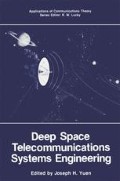Abstract
Successful radio communication between spacecraft and earth stations depends upon the use of appropriate radio frequencies and upon having sufficient freedom from interference. Radio frequencies for deep-space research may be chosen from bands that are allocated for that purpose. The choice of particular frequencies within those bands is guided mostly by the need to avoid interference between deep-space missions. Interference may also result from terrestrial sources making transmissions not related to space research.
Access this chapter
Tax calculation will be finalised at checkout
Purchases are for personal use only
Preview
Unable to display preview. Download preview PDF.
References
Radio Regulations, International Telecommunication Union, Geneva, 1981.
Recommendations and Reports of the CCIR, 1978, Volume II,Space Research and Radio Astronomy, International Telecommunications Union, Geneva, 1978 and subsequent issues.
Deep Space Network/Flight Project Interface Design Handbook,810–5 Rev. D., TRK-20, Rev. B, Jet Propulsion Laboratory, Pasadena, Calif., January 1981 and subsequent revisions (an internal document).
de Groot, N. F., and Sue, M. K., “Selection of Frequencies for Deep-Space Telecommunications,” TDA Progress Report 42–69, Jet Propulsion Laboratory, Pasadena, Calif., June 15, 1982.
Hersey, D. R. and Sue, M. K., “Maximum CW RFI Power Levels for Linear Operation of the DSN Block IV Receiver at S-Band Frequencies,” TDA Progress Report 42–56, Jet Propulsion Laboratory, Pasadena, Calif., Apr. 15, 1980.
Sue, M. K., “Block IV Receiver Tracking Loop Performance in the Presence of a CW RFI,” TDA Progress Report 42–60, Jet Propulsion Laboratory, Pasadena, Calif., Dec. 15, 1980.
] Manual of Regulations and Procedures for Federal Radio Frequency Management,National Telecommunications and Information Administration, United States Department of Commerce, Washington, D.C. 1979 and subsequent revisions.
Sue, M. K., “DSN RFI Susceptibility Model Development: Program Overview,” TDA Progress Report 42–68, Jet Propulsion Laboratory, Pasadena, Calif., Apr. 15, 1982.
Low, P. W., “Radio Frequency Interference Effects of Continuous Sinewave Signals on Telemetry Data,” DSN Progress Report 42–40, Jet Propulsion Laboratory, Pasadena, Calif., Aug. 15, 1977.
Low, Pauldit, “Radio Frequency Interference Effects of CW Signals on Telemetry Data: Part II,” DSN Progress Report 42–51, Jet Propulsion Laboratory, Pasadena, Calif., June 15, 1979.
Sue, M. K., “Telemetry Degradation Due to a CW RFI Induced Tracking Error for the Block IV Receiving System with Maximum Likelihood Convolutional Decoding,” TDA Progress Report 42–61, Jet Propulsion Laboratory, Pasadena, Calif., Feb. 15, 1981.
Sue, M. K., “Performance Degradation of the Block IV Telemetry System Due to the Presence of a CW Interference,” TDA Progress Report 42–69, Jet Propulsion Laboratory, Pasadena, Calif., June 15, 1982.
Editor information
Editors and Affiliations
Rights and permissions
Copyright information
© 1983 Springer Science+Business Media New York
About this chapter
Cite this chapter
de Groot, N.F. (1983). Radio Frequency Selection and Interference Prevention. In: Yuen, J.H. (eds) Deep Space Telecommunications Systems Engineering. Applications of Communications Theory. Springer, Boston, MA. https://doi.org/10.1007/978-1-4757-4923-6_11
Download citation
DOI: https://doi.org/10.1007/978-1-4757-4923-6_11
Publisher Name: Springer, Boston, MA
Print ISBN: 978-1-4757-4925-0
Online ISBN: 978-1-4757-4923-6
eBook Packages: Springer Book Archive

